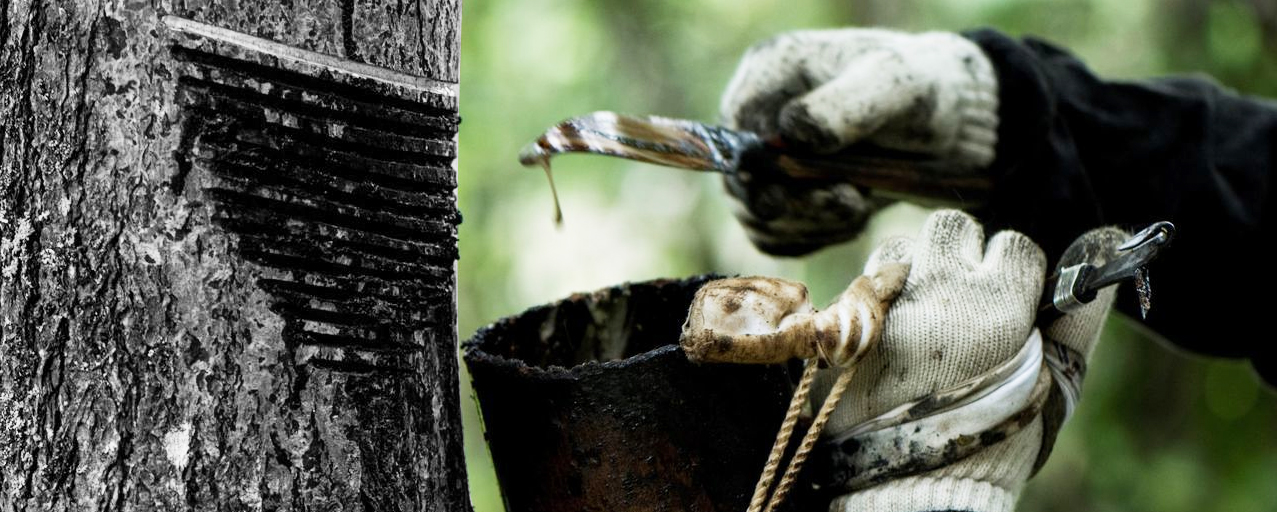What is urushi?
Urushi lacquer is a latex extracted from trees growing in some Asian countries (in areas 500 meters above sea level), with a temperature range from 8 to 20° C and in which the rainfall exceeds 0,6 m a year.
The urushi lacquer is the most fine because the climatic conditions in Japan are the most favorable to obtain a high quality product.
The urushi harvesting process (Urushi kaki)
Lacquer is obtained from the sap of the Rhus Verniciflua, a tree of the Anacardiaceae family.
Lacquer trees originally grew in the wild while for many centuries they have been cultivated.
The main harvesting time of urushi is between the middle of june and the end of september.
First tapping, called hatsuhen, is made from may to june.
Second tapping, called sakarihen, is made from june until september.
Third or late tapping, called osohen, is up to the end of november.
The sap of the lacquer flows in channels inside the plant. If the tree is damaged, the channels break and the sap the comes out.
This is what happens when a cut is made on the bark of the tree and a substance similar to latex leaks out: the raw lacquer.
It is a rather rare substance because even under ideal conditions mature lacquer trees produce a small amount.
The lacquer harvest takes place in mid-June and continues until the first cold weather (mid-October).
The trees used for extraction are carefully chosen, so that, in order not to damage the plant at all, each tree is used every three years and only four or five times during its life.
Modern harvest is carried out by making a series of horizontal incisions in the bark. The shape and style of the engravings varies from area to area.
Raw urushi lacquer (ki urushi)
Fresh lacquer has a milky-white or gray-yellow color that darkens as soon as it is exposed to the air.
After harvesting, the lacquer is immediately placed in a cup and covered to prevent it from hardening.
Once extracted, the lacquer needs to be clarified and processed. Twigs and other impurities must be filtered before further refinement.
Different degrees of purity of lacquer are used for different purposes.
The one used for the base layers does not require further refinement.
Raw lacquer is a protective, non-corrodible, acid and heat resistant, waterproof, luminous, shiny and long-lasting coating.
Freshly harvested lacquer contains 25 to 65% water, an amount that depends on where and when it’s extracted.
The presence of water is shown by a beige color, a milky appearance and a greater opacity of the viscous liquid.
Urushi-kurome
Excess water can be removed from the lacquer to help harden, to improve the transparency and strength of the final product. For this purpose, the lacquer can be heated to temperatures around 40 ° C.
Chemical properties of lacquer
The main component of the lacquer is urushiol.
Urushiol is a mixture of phenol derivatives suspended in water with a small percentage of proteins, or rather an oil in aqueous emulsion.
The lacquer does not harden by evaporation of the solvent but by polymerization in the presence of humid air.
The molecule polymerizes under the influence of an enzyme (laccase) which forms very resistant chains with a cross-linked structure, according to a hydropolymerization process, that takes place in the presence of oxygen.
Urushiol is in fact responsible for the cross-linking that makes the lacquer so resistant and durable.
It is qualified as a thermosetting polymer due to the irreversibility of the hardening process.
Since lacquer curing depends on water and oxygen in the air, the surface layers are the first to start the reaction, sealing the underlying layers.
The curing process of urushi
Urushi starts to hardened under defined conditions.
A fundamental parameter is the humidity which must be very high, from 75 to 85 %. The temperature is around 23-26 °C.

Allergic reaction
Many people show a more or less strong allergic reaction (Toxicodendron dermatitis or Rhus dermatitis) to not hardened urushi lacquer.
The extend, degree of severity and duration of the symptoms depends on the personal sensibility level, the quantity and duration of exposure to urushiol.
For this reason please always use thick gloves and covering clothes to protect your skin!


